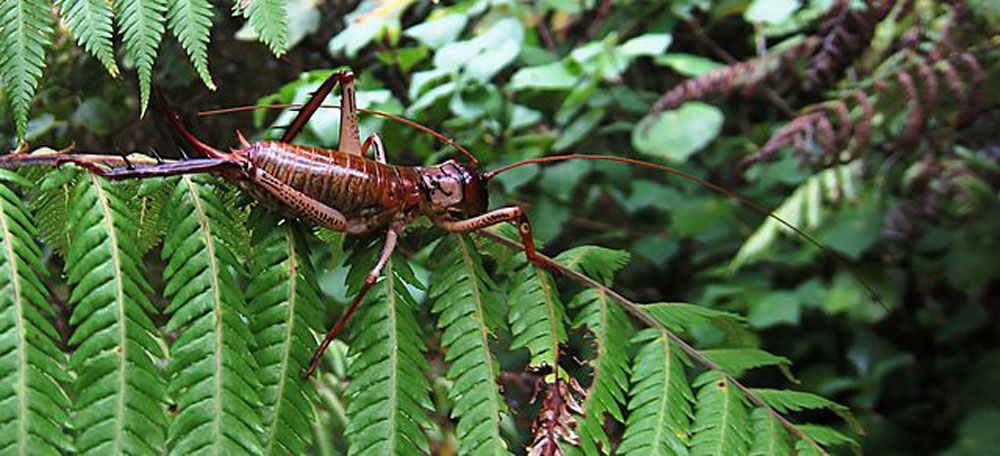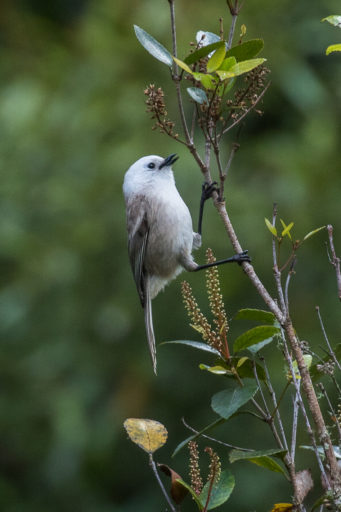Wētā are one of our most studied insects and are regarded as ‘bioindicators’ of the health of forest ecosystems. So when introduced predators – including mice – were removed from Maungatautari, the response of the local wētā population was followed closely by researchers.

But how well does the wētā response reflect what’s happening to other invertebrates? Researchers Corinne Watts, John Innes, Vanessa Cave, Danny Thornburrow and Stephen Thorpe decided to take the research a step further, monitoring and comparing the responses of both wētā and beetle species at Maungatautari to see how overall abundance and diversity of species responded to predator removal.
Their monitoring continued for a number of years, firstly as introduced mammals were removed and then as mouse numbers began to grow again in the absence of larger mammal predators.
“Predation by introduced insectivorous mammals is now widely recognized as a major factor contributing to the decline and extinction of many New Zealand native invertebrates. The effects of such predation has long been suspected because New Zealand’s invertebrate fauna evolved in the absence of terrestrial mammals, except for bats. Invertebrates dominate the diet of small mammals, but few studies have quantified the effects that insectivorous mammals have on native invertebrate populations or communities. We investigated responses of beetle and wētā communities to mammal eradication at two fenced forest sites at Maungatautari.”

The Maungatautari Ecological Island Trust erected mammal-resistant fences and attempted to eradicate all introduced mammals from Maungatautari in 2004.
“The restoration on Maungatautari proceeded in stages with the initial establishment of two pest-proof fenced exclosures on the northern (35 ha) and southern (65 ha) sides of Maungatautari. During September–October 2004, mammals including mice were eradicated from these exclosures as a trial for the entire mountain. In the southern exclosure, the focus of our study, four ship rats and five mice were detected and removed by trapping between November 2004 and May 2006. Between January 2007 and February 2013, there were no confirmed mammal incursions into the southern exclosure.”
“To eradicate mammals from the entire mountain, a pest-proof fence was built (completed by August 2006) and a prolonged mammal eradication operation started in November 2006. All mammals became very scarce, but mice were likely never eradicated from the entire reserve. With ongoing mouse control becoming unsustainable, no further mouse control was attempted after February 2012 and since then they have become increasingly abundant.”
The eradication project provided an ideal opportunity to investigate changes in the invertebrate fauna following mammal eradication.
“Objectives of the current study were to:
(1) investigate the changes in the beetle community following mammal eradication on Maungatautari;
(2) determine whether beetle functional traits can explain why certain elements of the beetle community responded, and specifically we predict that ‘larger’ beetles (> 13 mm) will be more prevalent at Maungatautari following mammal eradication;
(3) examine how wētā responded to mammal eradication on Maungatautari between 2004 and 2013;
(4) investigate whether wētā abundance provides a reliable indicator of beetle abundance.
It wasn’t expected that numbers of all invertebrates would necessarily increase as predator/prey interactions are complex.
“Invertebrates should not always be expected to increase in abundance after numbers of mammalian predators are reduced, although populations of some large-bodied invertebrates may increase. One reason for this is that removing predatory mammals may result in increased abundance of insectivorous birds, and this may have a confounding effect on how invertebrates respond. The eradication of mammals from New Zealand forests is considered a major ecological intervention so we should expect complex, varied, and possibly surprising outcomes for the invertebrate fauna and the ecosystem as a whole.”
Beetles and wētā were sampled from two transects of pitfall traps situated within the southern exclosure (‘inside’ transects) and two outside the exclosure but inside the main fence (‘outside’ transects). Sampling began approximately 6 weeks after the mammal eradication commenced in the southern exclosure in 2004 and continued for 8 summers.
“Beetles were sorted on the basis of external morphology to recognisable taxonomic units (RTUs) and then, where possible, were identified to genus and species. Beetle species were classified into functional groups (herbivores, detritivores and predators) at family or subfamily level. Additionally, each species was classified as ‘minute’ (<2 mm), ‘small’ (3–7 mm), ‘medium’ (8–12 mm) or ‘large’ (>13 mm). Beetles were classified as native or introduced.”
“Wētā caught in the pitfall traps were classified as adult H. thoracica (Auckland tree wētā), or as ‘other wētā’ that included subadult and juvenile H. thoracica and all age classes of ground wētā (Hemiandrus species) and cave wētā (Rhaphidophoridae species).”
Over the 8 summers of the study a total of 56,173 beetles comprising 206 identifiable species were collected, of which 195 were native. Only 90 (0.2%) of the beetles collected were introduced. Most species were either small detritivores or large predators.
“Ground-dwelling beetle abundance, but not species richness, increased inside the southern exclosure two years after all mammals were eradicated. In the next 5 years, when all mammals except mice were eradicated from all of Maungatautari, beetle abundance and species richness were frequently higher in the mouse-free southern exclosure.”
“Beetle community composition changed after mammal eradication, and over time with increasing mice densities outside the southern exclosure. Large, predatory, and native beetles showed the most differences between inside and outside the southern exclosure over some years.”
A total of 3,088 wētā were caught over the 8 year period, of which 969 were adult H. thoracica (470 female, 499 male).
“Wētā were more responsive to mammal removal than beetles. Wētā abundances both inside and outside the southern exclosure were similar when most mammals were eradicated and mice were controlled to low numbers. However, wētā declined in the following 2 years outside the southern exclosure when mouse abundance increased.”
So what can be interpreted from the results?
“Although this study was based on a modest sample of pitfall traps dispersed through time, some interesting results have emerged. Beetle abundance, but not species richness, increased inside the southern exclosure within 2 years after all mammals were eradicated. In the subsequent 5 years, during which all mammals except mice were also eradicated from the main Maungatautari reserve, beetle abundance and species richness were higher in four of six years within the mouse-free southern exclosure, which suggests mouse predation outside.”
Predator-prey interactions can be complex, however – and predator-deterring fences don’t stop invertebrates from straying across boundaries. Climatic impacts can also vary from year to year.
“Although complex interactions appear to be occurring, species richness and abundance certainly started to increase after predator control was implemented at the wider scale on Maungatautari, even inside the southern exclosure. It was assumed that the transects within the southern exclosure would have been sufficiently buffered from what was occurring outside the southern exclosure, but it is possible that insect communities are roaming more widely that we acknowledge and the response is much stronger later due to this wider buffer. Both sites showed a peak in beetle abundance and species richness in the summer of 2009/10, perhaps because drought-breaking rain occurred then.”
“In 2009/10, mice were still being targeted with control in the main reserve, so that the few mice present there were apparently unable to consume enough beetles to prevent beetle abundance from equalling that inside the mouse-free southern exclosure. If the 2009/10 year beetle results reflect an anomaly driven by environmental conditions, then overall beetle abundance and richness trends after predator control (between 2010 and 2013) is rather flat. This would support the discussion that this indicates a short period of mammal predator release curtailed by replacement with bird predation.”
Pōpokotea/whitehead are insectivorous birds and were translocated to Maungatautari in 2009.
“Endemic bird species, particularly insectivorous species such as tomtit and whitehead were more abundant and widespread on Maungatautari in 2014 than in pre-eradication surveys. These bird increases could account for the decrease in beetles after summer 2009/10.”

“The scenario of abundant mice after all other mammal species are eradicated within fenced areas is becoming commonplace in New Zealand. In another recent Maungatautari study, mice reduced the abundance and size of ground-dwelling invertebrates when they were the only mammal present. It could be that increasing bird and mouse abundances combined caused the decline in ground-dwelling beetles after summer 2009/10.”
The authors suggest that further research measuring environmental variables (e.g. litter depth, canopy density) that could be important habitat for invertebrates would be valuable.
“It is also possible that the time that the beetle community was monitored on Maungatautari was not long enough to detect the changes after mammal eradication. There is little known about the life histories of many New Zealand invertebrates, and it has been proposed that the responses of invertebrates (with multi-year developmental stages) to mammal eradication might only become obvious after at least 10 years.”
And then there were the beetles that actually declined when mammal predators were removed.
“Conversely, some taxa declined following mammal eradication, including the small rove beetle (Aleocharinae spp.), which was common when a suite of mammals was present and species of Sepedophilus, which were abundant when only mice were present. More detailed studies are required to determine why these taxa would increase.”
“Analysis of the beetle community from a functional trait perspective showed that large, predatory, and native beetles differed the most between inside and outside the southern exclosure over some years. The significant ‘native’ beetle result is likely to be a correlation with the ‘large’ and ‘predatory’ traits, since nearly all beetles caught were native. Of the 21 ‘large’ beetle taxa caught, 12 (57%) were predators. These data could indicate that a roaming predatory lifestyle may increase vulnerability to mammal predation. This warrants further research.”
Wētā were found to be more responsive to mammal removal than beetles, so are wētā effective invertebrate indicators?
“In the present study, the number of adult H. thoracica (Auckland tree wētā) and ‘other wētā’ caught were statistically significant predictors of geometric mean beetle abundance, but examination of the predicted values revealed substantial inconsistencies. The data suggest that ‘other wētā’, especially those outside the southern exclosure, possibly behaved more like the beetle community. Therefore, we suggest that at a broad community level, tree wētā are not a consistent indicator but are probably more appropriate for representing taxa that are trait-wise comparable, such as large arboreal herbivores (e.g. stick insects).”
Pitfall traps were used in this research project, but there are numerous techniques available for sampling invertebrate communities, including pitfall traps, malaise traps, visual searching, suction traps, insecticide fogging, sticky traps, light traps, and sweep-netting. However, any invertebrates have different functional traits, preferred habitats, and behaviour/ecology, meaning more than one sampling method may be desirable when studying forest invertebrates.
“In the present study, pitfall traps were used to sample the ground-dwelling invertebrate fauna because they are cost effective to set up, inconspicuous, require little maintenance over a multi-year study, and sample taxa likely to be consumed by mammals and birds. It is likely that if different invertebrate sampling techniques were deployed at Maungatautari, then the results found would be different. In addition, if different taxonomic groups were selected for analysis, then the outcomes would also likely be different. We do not know how invertebrates such as canopy-dwellers respond to mammal control and eradication. Taxonomic description of more invertebrate species is also required to enable interpretation of species and community responses to perturbations.”
So what do we know about mammal impacts on invertebrates, and the benefits of mammal pest control?
“The responses of beetles, and invertebrates generally, to the eradication of mammals are not uniform. The abiotic and biotic factors affecting the invertebrate fauna are complex, and these interactions are poorly understood. It is likely that the invertebrate taxa originally most affected by mammals are already extinct on Maungatautari, and generally on mainland New Zealand. Furthermore, the species that are extinct on the mainland may be less available for assisted recolonisation by translocation from mammal-free offshore islands than threatened birds.”
“Recently, analysis of ground-based control by TBfree New Zealand and conservation agencies found that the only widespread species that has been shown to increase after mainland pest control is H. thoracica, probably because it is a favoured prey of ship rats.”
When invertebrates are no longer preyed on, what are the wider benefits for the ecosystem?
“We currently have no or limited knowledge regarding how invertebrate-driven ecosystem processes, such as pollination or decomposition, respond after mammal control/eradication. Switching the focus of monitoring to these functions is worth investigation.”
The full research report is published in the New Zealand Journal of Zoology. Only the abstract is freely available online to non-subscribers.

